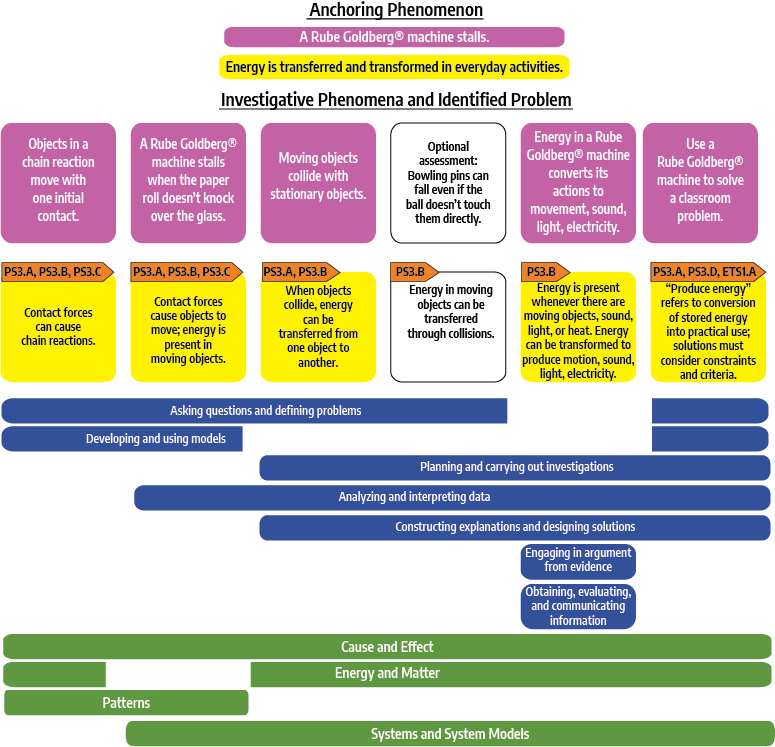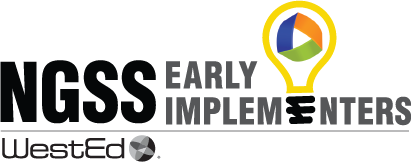
The anchoring phenomenon for this unit is: A Rube Goldberg® machine stalls. In this unit, students recognize that energy transfers and transforms in everyday life as they explore the flow of energy within and between systems. They identify observable changes that occur, where the energy comes from, and where the energy goes. Students investigate energy transfer from place to place and recognize that the faster an object is moving the more energy it possesses. Students investigate energy transformation as the energy source is converted in its actions and apply their understanding by designing a device that transforms energy.
The Performance Expectations (PEs) addressed in this unit are:
| 4-PS3-1 | Use evidence to construct an explanation relating the speed of an object to the energy of that object. |
|---|---|
| 4-PS3-2 | Make observations to provide evidence that energy can be transferred from place to place by sound, light, heat, and electric currents. |
| 4-PS3-3 | Ask questions and predict outcomes about the changes in energy that occur when objects collide. |
| 4-PS3-4 | Apply scientific ideas to design, test, and refine a device that converts energy from one form to another. |

The Learning Sequence Narrative briefly describes what students do in each lesson and links the learning between the lessons as a conceptual storyline. At the end of each lesson, students make connections to their understanding of the investigative phenomenon (and to the anchoring phenomenon if appropriate).
The investigative phenomena for the learning sequence are various Rube Goldberg® machines in which objects move. Students figure out these phenomena by:
Asking Questions and Defining Problems
Developing and Using Models
Planning and Carrying Out Investigations
Analyzing and Interpreting Data
Constructing Explanations and Designing Solutions
Engaging in Argument from Evidence
Obtaining, Evaluating, and Communicating Information
PS3.A: Definitions of Energy
PS3.B: Conservation of Energy and Energy Transfer
PS3.C: Relationship Between Energy and Forces
PS3.D: Energy in Chemical Processes and Everyday Life
ETS1.A: Defining and Delimiting Engineering Problems
Patterns
Cause and Effect
Systems and System Models
Energy and Matter
The following Learning Sequence Narrative is based on the conceptual flow concept map above.
Investigative Phenomenon: In a Tom and Jerry cartoon, objects in a chain reaction move with one initial contact.
This lesson introduces the students to the investigative phenomenon of chain reactions in a mousetrap in a Tom and Jerry cartoon (similar to a Rube Goldberg® machine) as a common experience for their learning. Students use their prior knowledge from kindergarten through third grade about force and motion to observe and describe chain reactions in terms of action (e.g., movement) and how the action occurred (e.g., forces). They explain their observations in terms of their prior knowledge about energy (DCI), cause and effect (CCC), and in how they ask questions (SEP).
Investigative Phenomenon: A Rube Goldberg® machine stalls when the paper roll doesn’t knock over the glass.
In this lesson, students investigate a Rube Goldberg® machine (chain reaction) that stalls. Students compare and contrast the sections of the system that work and those that don’t in terms of force, energy (as they understand it), collisions, and speed. They learn about systems (CCC) in terms of their components and interactions by investigating (SEP) their section/part of the Rube Goldberg® machine to begin to explore: what is the system of interest? What are the parts of the system? What observable changes are taking place in the system? How is the energy transferred? Where does it come from, what does it do, and where does it go? They look for cause and effect relationships (CCC) and patterns (CCC) in the data.
Investigative Phenomenon: In a Rube Goldberg® machine, moving objects collide with stationary objects.
In this lesson, students use the knowledge gleaned from their observations of energy transfers to describe energy in terms of speed and collisions by noticing patterns (CCC) and cause and effect relationships (CCC) They plan and conduct an investigation(SEP) about the relationship of speed and energy to collisions of objects. Students also construct an explanation using evidence (SEP) from their investigation to support the claim that faster-moving objects have more energy. Finally, they recall the failed Rube Goldberg® machine from Lesson 2: Oops! and propose a solution.
Investigative Phenomenon: Bowling pins can fall even if the ball doesn’t touch them directly.
Use this optional assessment if students need support to understand that observations can produce data as evidence, that within a system, moving objects contain energy, that the faster the object moves, the more energy it has, and that energy can be moved from place to place by moving objects. Students conduct an investigation (SEP) to continue their exploration of how energy moves and formally label this movement as energy transfer. Students continue their exploration of how contact forces transfer energy between components within a system (CCC). Students think about the questions from Lesson 2: Oops! What is the system of interest? What are the parts of the system? What observable changes are taking place in the system? How is the energy transferred? Where does it come from, what does it do, and where does it go?
Investigative Phenomenon: Energy transfers can be observed in parts of a Rube Goldberg® machine where energy converts its action to movement, sound, electricity.
In this lesson, students test various devices (SEP) that convert an energy source into a different action (e.g. rubbing hands together to produce heat and sound). Students make observations to produce data that they analyze for trends or patterns that they will use as evidence to construct an explanation. They also learn to refine their arguments based on an evaluation of the evidence. They continue to recognize that energy can be transferred in various ways between objects and continue to ponder the system (CCC). They revisit the questions from Lesson 2: Oops! What is the system of interest? What are the parts of the system? What observable changes are taking place in the system? How is the energy transferred: Where does it come from, what does it do, and where does it go?
Identified Problem: Use a Rube Goldberg® machine to solve a classroom problem.
In the last lesson of the unit, students apply their understanding of energy and its transfer/ transformation in a design solution (SEP) to meet human needs. Students design a Rube Goldberg® machine that humorously solves a classroom problem (CCC) using the principles of engineering (defining a simple design problem that can be solved by the development of a tool using criteria and constraints; making observations to produce data to serve as the basis to test a design solution; applying scientific ideas and evidence to the design of a prototype tool; and comparing and evaluating solutions based on how well they meet the criteria and constraints of the design). At the end of the lesson, students recognize that a Rube Goldberg® machine is a fun but impractical use of energy. Students link different cards to show energy being used for practical purposes.Chelsea Cochran, Science Coordinator, San Diego County Office of Education
Kathy DiRanna, K-12 Alliance Statewide Director, WestEd
Alyssa Nemechek, Core Leadership Team and 4th Grade Teacher, Palm Springs USD
Lana Van, 4th Grade Teacher, San Diego USD
Ursula Fabiano, 4th grade teacher, Palm Springs USD
Claudia Razo, 4th grade teacher, Palm Springs USD
Alyssa Nemechek, Core Leadership Team and 4th Grade Teacher, Palm Springs USD
Diane Deem, Core Leadership Team and 4th Grade Teacher, Vista USD
Achieve Science Peer Review Panel

A Collaboration of the K-12 Alliance @ WestEd, Aspire Public Schools, Galt JUSD, High Tech High, Kings Canyon USD, Lakeside USD, Oakland USD, Palm Springs USD, San Diego USD, Tracy USD, Vista USD, Achieve, and the California Department of Education
with funding from the S.D. Bechtel, Jr. Foundation and Hastings-Quillin Fund
Rube Goldberg® is a registered trademark of Rube Goldberg, Inc. All materials used with permission. rubegoldberg.com
The California K–8 NGSS Early Implementation Initiative was developed by the K–12 Alliance at WestEd with close collaborative input on its design and objectives from the California State Board of Education, the California Department of Education, and Achieve. This project was designed to build local education agency (LEA) capacity to fully implement the Next Generation Science Standards (NGSS) as a core subject in the elementary grades (K–5) and as the SBE’s preferred integrated model in grades 6–8.
The six-year Initiative provided teachers and administrators with in-depth, content-rich professional development to build leadership capacity and teacher acumen to deliver high-quality 3-dimensional learning for K–8 students. In addition, through collaborations among the K–12 Alliance, Achieve, and others, the LEAs in the Collaborative have opportunities to pilot test new NGSS-aligned tools, processes, assessment item prototypes, and digital and other instructional materials. The LEAs continue to serve as resources for NGSS implementation across California, and in other NGSS-adopting states as well.
This resource presents the conceptual storyline for a unit of instruction at a specific grade level, then focuses on a portion of the storyline called a learning sequence. The learning sequence uses the three dimensions of the NGSS (disciplinary core ideas–DCI; science and engineering practices–SEP; and crosscutting concepts–CCC) to build and deepen student understanding of natural phenomena and design challenges.
Participants in the CA NGSS K–8 Early Implementation Initiative developed and field-tested the lessons in the learning sequence.
NGSS Lead States. 2013. Next Generation Science Standards: For States, By States. Washington, DC: The National Academies Press.
A Framework for K–12 Science Education: Practices, Crosscutting Concepts, and Core Ideas. DOI: https://doi.org/10.17226/13165. National Research Council; Division of Behavioral and Social Sciences and Education; Board on Science Education; Committee on a Conceptual Framework for New K–12 Science Education Standards. National Academies Press, Washington, DC.